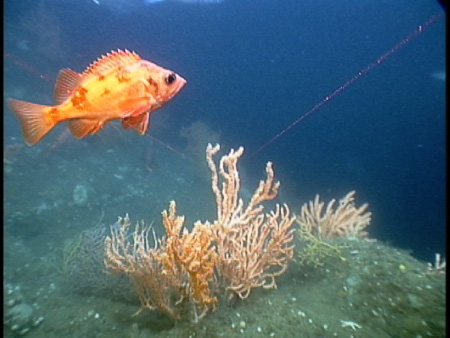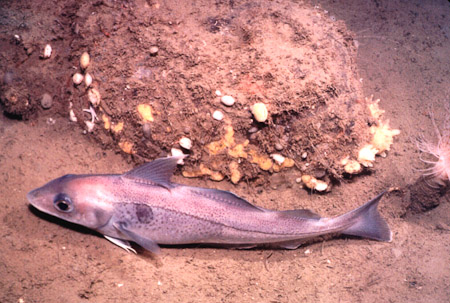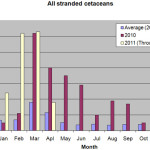
Eric Heupel is a graduate student at University of Connecticut in Oceanography. He keeps a personal blog at Eclectic Echoes and Larval Images, and used to be part of The Other 95% team along with me before we closed shop. You can find Eric tweeting as @eclecticechoes.
—————————————————-
A few weeks ago there was an op-ed piece in the New York Times by Prof. Ray Hilborn which asserted that people should eat more fish, and do it without guilt. I agree that people should eat fish. I know I enjoy it weekly. I also agree with many of the points he brings up, but I have to disagree with a few key assertions he makes and I come to an entirely different conclusion about the state of American fish stocks.

Prof. Hilborn points out that many stocks and the management of fisheries have improved drastically over the past decade (true) and that, as an example, Acadian redfish and haddock from the New England Coasts groundfish fisheries have had six fold abundance increases (again true). He acknowledges that these two species are part of the complex mutli-technology multi-species groundfish fishery, which also includes cod and four species of flounder (among others), whose stocks have not improved and remain classified as overfished. This fishery is dominated by demersal trawlers, which drag otter trawls across the bottom. While there are mesh size limits, the otter trawl is a very unselective method of fishing, bringing up any fish in the way, target and non-target species. Some of the non-target species include cusk and wolffish, two species that many have recently argued should be listed as endangered species and are currently classified as species of concern under the Endangered Species Act. There are new trawl net designs which will target haddock preferentially over cod, flounder and several other groundfish based on different flight responses to trawl net approaches, but they have not yet been widely adopted. While the groundfish fishery is dominated by trawlers (80%), there is also a hook and line fishery for haddock. The hook and line fishery is very selective. If you want a haddock for dinner, the hook and line caught haddock is a great choice.
Interestingly, Prof. Hilborn points to the Fishery Stock Sustainability Index (FSSI) to make the claim that, “Few if any fish species in the United States are now being harvested at too high a rate, and only 24 percent remain below the desired abundance.” Even if I could come to the same conclusion from reading the latest FSSI, his statement would mean, to me, that the management improvements of the past 10-15 years are starting to work, and now we need to improve as much of the remaining 24 percent as we can. Unfortunately the FSSI does not say this. First, Prof. Hilborn states that only 24 percent of the stocks remain below desired abundance, yet the FSSI states we don’t even know if 53 of the 230 (23%) tracked stocks are overfished or not and only 110 stocks of 230 (48%) are at or above the maximum sustainable yield (the desired “abundance” for most stocks).
The FSSI is basically a fisheries management report card evaluating 230 key recreational and commercially important marine fish stocks and their management. Each stock is graded from 0 to 4 based on 5 criteria – 0.5 points for the “overfished” status being known, 0.5 points for the “overfishing” status being known, 1 point if overfishing is not currently occurring, 1 point for stocks with biomass above the overfished level defined for that stock, and finally 1 point for species with biomass above the maximum sustainable yield at or above 80% of the biomass maximum sustainable yield. Stocks which were previously classified as overfished do not receive the final point until they are considered “fully rebuilt” by reaching biomass maximum sustainable yield, a condition mandated by the Magnuson-Stevens Act.
With 230 stocks evaluated, the maximum score is a 920. The most recent quarterly evaluation (pdf file) (Jan to March 2011) yielded a score of 583 or 63%. If we use the report card analogy and assigning a letter grade, that would be a “D”. While I applaud the recent gains in stocks and the management methods that have helped bring them about, I don’t think a D is a grade to celebrate. Prof. Hilborn appears to be saying, ”Thats good enough! Time to return to the more lenient management of the 80s and early 90s.” I wish we were there, and we could be in another decades or so, but sadly we really aren’t there yet. We certainly won’t get there if we start fishing more too soon.
All of this assumes that our current management schemes and the way they are evaluated are working towards the appropriate goals. I am not convinced that we are managing for the right goals. Most of our fisheries management is for single stocks. Even in the multi-species stocks, the management of the collected stocks is for the biomass or abundance of the individual species, because they are most often caught together with non-specific gear. There has not been, until very recently, any substantial effort to protect essential fish habitat, or to examine the ecosystem implications of fisheries beyond the target species.

The Magnuson-Stevens Act (MSA) was enacted to “take immediate action to conserve and manage the fishery resources found off the coasts of the United States.” The definition of “conserve and manage” includes the explicitly listed requirement to assure that “(ii) irreversible and long-term adverse effects on fishery resources and the marine environment are avoided” (16 U.S.C. 1802, MSA Section 3(5)(B)(ii)). President G.W. Bush’s Stewardship of the Ocean, Our Coasts, and the Great Lakes executive order further explicitly stated that “it is the policy of the United States to: (i) protect, maintain and restore the health and biological diversity of ocean, coastal and Great Lakes ecosystems and resources; (ii) improve the resiliency of ocean, coastal and Great Lakes ecosystems, communities and economies.” While I agree it may never be possible to make the oceans pristine again (shifting baselines – we’ve forgotten what pristine is anyways) it seems clear to me from these documents that we must continue to do everything possible to protect not only individual fish stocks and fisheries, but the biodiversity of our seas and ecosystem health of our seas as well. This is something that has only recently been able to be implemented into fisheries management at all.
Prof. Hilborn concludes his editorial by throwing up a false choice between easing fishing regulations now or accepting terrestrial habitat loss, more dead zones, and water pollution: “environmental costs of producing meat on land are much higher than accepting fewer fish in the ocean”. Of course, we have regulations (Clean Water Act) to limit industrial run-off, including from meat production, which covers all of the impacts he points to except one: habitat. Interesting. Does fishing not destroy habitat then? The truth is that it does, especially trawling. I would suggest that part of our improved ecosystem and biodiversity management needs to be a focus on marine habitat. We need to set aside many more areas explicitly to protect the range of benthic habitats, especially those which include sensitive and vulnerable benthic species such as cold water corals, sea pens, etc. The beautiful part is, protecting these habitats (and allowing those that are impacted to fully recover), is not only protecting biodiversity and improving the health of the local marine ecosystem, but it will also improve the health of many fish stocks as well.
I agree, eat fish, and do it guilt free by using guides from Monterey Bay Aquarium’s Seafood Watch or the Blue Ocean Institute’s Seafood Guide or looking for the MSC certification logo. Far from being time to revise the MSA to relax policies, I think it is time to continue to implement the full definition of “conserve and manage” to include ecosystem health and the protection of biodiversity.





Thanks for the fleshed out explanation, Eric!
President G.W. Bush’s Stewardship of the Ocean, Our Coasts, and the Great Lakes executive order!? Do you mean President Obama’s Executive Order 13547?
Ashley, Nice catch.
Yes I do mean Executive Order 13547, which was signed by President Obama, superseding an executive order by President Bush which established the Ocean Council. Sorry about the confusion.
Awesome post Eric. Thank you. I am working on a Hilborn op-ed response too and your article helped me understand the FSSI. And I had the same reaction as you: when you actually look at it, it doesnt paint the rosy picture Ray claims it does. It also doesnt evaluate the state of lots of fished and overfished fish (and inverts). For example, in the tropical benthic systems I work in, almost nothing is evaluated. It also ignores countless species indirectly impacted by fishing. Even if the grade was an A, this could hardly be used to rationally justify increasing fishing and seafood consumption.
Thanks John! I look forward to seeing your response as well.
One of the annoying things about Ray’s arguments is that he either ignores or just glosses over the fact that so many fisheries around the world there is no fisheries independent data (if there is data at all!) as you point out. I fail to understand how one can make a conclusion about global fisheries from a handful of fisheries that are (relatively) well managed and for which we do have decent data.
Rather like me claiming it s clear and sunny the world over after looking out my window, and then calling up 5 friends who all live nearby and asking what the weather is out their windows. Illogical
Slight correction to your interpretation of the fourth score point under FSSI. Reading from the NFMS FSSI webpage – the fourth score point is for a stock with biomass at or above 80% of the biomass that produces maximum sustainable yield (BMSY), except for stocks rebuilding from a previously overfished condition – they are not awarded the fourth point until they reach BMSY , as mandated by the Magnuson-Stevens Act. After they have been fully rebuilt, they may fluctuate within the 80% parameter and retain the score of 4 like the other non-rebuilding stocks
Thank you Peter! A subtle but important distinction. I’ll see about getting the line changed to match the FSSI.
That’s a great post Eric! Overfishing is a worldwide phenomenon. This reference of Prof. Hilborn’s is looking at American waters. I wonder if you could point me to any reference on global findings. Would appreciate greatly.